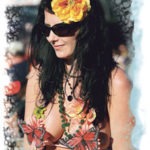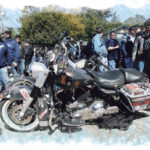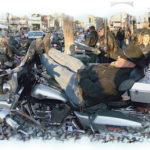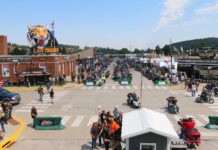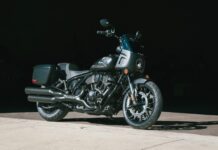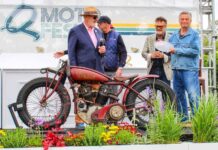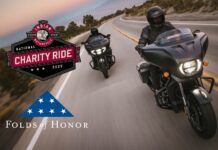Hot time in a cold town
Taking a chill amid signs of a thawing economy
Daytona Beach, Feb. 27–Mar. 7—Desperate times call for desperate measures, and the beer girl standing over her tub of iced suds at the Full Moon Saloon on Main Street is making a yeoman’s effort to uphold the hallowed tradition of Bike Week beer girls—i.e., to display some provocative flesh to any camera pointed in her direction. The camera is mine, and some patience is called for as the gal takes a few moments to excavate the layers of warm clothing she’s wearing to find some skin. Finally in a triumphant Eureka! moment, she locates her cleavage, exposes it and tops it off with a smile. Talk about professionalism.
It’s late on Saturday night, the kick-off weekend of Bike Week, and Main Street is abuzz despite a temperature that has dipped into the 30s. The crowd on the street is bundled to the teeth—leathers and hoodies, chaps and stocking caps—and exhaling white clouds, and the whole scene feels more like a toy run in Duluth than the halcyon Florida spring-break-for-bikers that’s fervently anticipated. But the will to party, embedded deep within the lizard brain of all self-respecting bikers, is strong tonight, and the throng of revelers will, by God, have a good time or freeze to death in the pursuit.
That spirit comes in handy this year as, with rare exception, the entire week is a frigid waiting game; waiting for the mercury to make it up to 60 degrees during the day, and waiting for the ceaseless winds to abate. And the mercury does make it up there, at least in some locales. It just takes most of the day to do it, and once there it nosedives back down and settles in the upper 30s on most nights. For many riders—the ones from the snowbound northern climes—conditions are still better than what they left behind and thus offer some tease of spring in the offing, but the leathers and stocking caps stay on. For the Southerners who comprise the majority of the attendees, though, it plain sucks.
As a consequence, the turnout for Bike Week, at least in the early going, is noticeably down from previous years. The upside of that downturn is the absence of the usual traffic backups on the main thoroughfares, shorter queues at the bars and restaurants, and an abundance of vacancies at motels in the rally region. That state of affairs persists until Friday, and it’s nice while it lasts, but then it changes dramatically as bikes pour into town for the final weekend, traffic gets balled up and the vacancies evaporate. And that’s nice, too, considering. Remarkably, business is booming all week long for the vendors around town, from Main Street to Destination Daytona—and it’s not just the leather and warm clothing purveyors, either, though they’re doing a particularly brisk trade (and even Wal-mart is reportedly sold out of long underwear). The consensus among the many retailers we talked to is that the wallets of the bikers are reopening at last after two years of austerity measures and that the two-wheeled economy is happily on the rebound.
Takin’ it to the Street
The biggest break this year from the Bike Week status quo of the recent past was the re-emergence of Beach Street as a principal player in the scheme of things. What started as an encouraging revitalization of the once-vibrant venue last year came into full flower for 2010, owing in equal measures to two factors. The first was the purchase of Halifax Riverfront Park by the Trust for Public Land last summer, a move that preserved the open space in perpetuity and settled the uncertainty surrounding the property, which had been ill-advisedly slated for condo development. The second and more significant factor was the decision by Harley-Davidson to relocate their operations and exhibitions from their long-standing residence in the stuffy Ocean Center convention facility adjacent to Main Street to an open-air tent pavilion in Riverfront Park, across Beach Street from the landmark Daytona Harley-Davidson. That move may well have been a due to budgetary considerations for the cash-strapped Motor Company, but it didn’t feel like a downsizing; it felt like a return to the street from the citadel on the hill, and a sort of recommitment to rubbing shoulders with their base and a re-embracing of the carnival culture of Daytona—an embrace that was absent in the sterile environs of the Ocean Center.
How refreshing. You could park at the curb right in front of the pavilion, buy a Budweiser from the beer girl posted there, and stroll the lot. A multitude of Motor Company employees circulated, meeting the visitors, making themselves available to any and all, and conducting a number of activities and demonstrations. Popular among those activities was the V-Rod drag race simulator that noisily pitted pairs of riders in dyno duels, and over at the women’s tent a Softail Deluxe sat on a stationary roller platform and women were invited to take a virtual test spin on the machine. Also in the mix was the booth of radio station WHOG (“The Hog”) from which broadcasts issued for several hours each day; broadcasts that included interviews with various H-D personalities including Bill and Willie G. Davidson and our personal favorite, party girl Leslie “Sly” Prevish, the Company’s outreach manager.
Harley’s presence was an important Beach Street development, but by no means the only one. Also joining the resurgence were a vast collection of mostly domestic OEM and aftermarket concerns, most notably Indian Motorcycle and Big Dog Motorcycle, which this year moved their trucks over from their previous setting out at the parking lot of Daytona International Speedway and set up camp across the street from their brick-and-mortar dealerships. The upshot of all of this was that Beach Street became a convenient retail adjunct to Main Street—located just across the Halifax River bridge—in a way similar to the role played by Lazelle Street in Sturgis. And the place drew the crowds. At times the sidewalks became congested to the point of shuffling and jostling along in Main Street fashion, though the wide four-lane boulevard continued to handle the traffic with relative ease. Bike parking in close proximity to the happenings was easy to come by, either on the street or in one of several free parking areas off-street.
Beach Street’s renewed vibrancy and popularity didn’t have any apparent impact on the continuing popularity of distant Destination Daytona in Ormond Beach, the crowning achievement of the late Bruce Rossmeyer, the Harley mega-dealer and tireless Daytona promoter who died in a bike wreck on his way to Sturgis last summer. Gone but not forgotten, Bruce’s corpulent visage continues to beam from billboards in the vicinity, giving you something to contemplate while sitting in the gridlocked traffic that seems a permanent fixture of the enormous complex. There’s no doubt that the place is a shopper’s paradise, and indeed a destination for thousands upon thousands of Bike Week attendees who crowd in pretty much any hour of the day. There’s also no doubt that something has to be done about the access traffic flow which gets so snarled at times that the exit ramp off adjacent I-95 is closed down, necessitating a 10-mile round trip up to Flagler Beach and back just to get in line to enter the grounds. Leaving the place isn’t much better, requiring a detour up US 1 for a distance before whipping a U-turn on the busy highway. But still they come. The will to shop is apparently as powerful as the will to party.
Meanwhile, back over in Harley-Davidson’s previous digs in the Ocean Center’s annex (finished last year just in time for both Bike Week and the economic meltdown), an abbreviated version of the International Motorcycle Show was emplaced. This was the final stop of the show after a long winter that saw it visit a total of a dozen cities nationwide, and its first appearance in Daytona in five years. Open to the public from Wednesday through Saturday of Bike Week, the usual $15 entry fee at the door charged elsewhere was waived in Daytona. Many of the programs and attractions of the national series remained on the menu, but it was a downsized affair with only Suzuki present among the major OEMs. The others, including Harley-Davidson, took a pass and for good reason. After all, pretty much all of them were set up and offering demo rides out at the Speedway, so why just look at a bike in a convention hall when you can take it for an actual test outing on the street? Nevertheless, the show floor was busy and offered a diversity of exhibitors you don’t find elsewhere. Where else, for example, can you find Korean manufacturer Hyosung in the same room with Sucker Punch Sally’s? Or find a display of vintage BSA machines next to the display of the Vintage Honda Motorcycle Club, and right down the aisle from a cutting-edge Confederate Wraith?
The year of the rat
If the resurgence of the Beach Street scene was the big news in the Daytona venue constellation, the most notable development this year moto-culturally speaking was the burgeoning lunatic fringe of American motorcycling represented by the Limpnickie Lot, a collection of bike builders and parts producers assembled, appropriately enough, at the Stone Edge Skate Park a few miles down Ridgewood Avenue from the Main/Beach party zone. Collectively called the Limpnickie Collective, thisgroup is a ragged rat-bike-fancying bunch of Gen X and Y thrashers who profess to speak for a new generation of bikers, and embrace a hip young gestalt of choppers, skateboards, paintball, punk and metal. They also share a professed disdain for the stodgy old mainstream Harley riders of the Baby Boomer generation found over on Main Street; the generation which, incidentally, invented choppers, skateboards, paintball, punk and metal.
I suppose I should be insulted, being a Boomer and all, but I begrudge them the point. There’s plenty about the direction that the notion of biker culture has taken in the new century that I find cringe-worthy as well, and my visit to the Lot on Wednesday was paradoxically less of an immersion in something fringy and radical as it was a nostalgic interlude. That’s because it became quickly apparent as I surveyed the Limpnickie machinery that these guys aren’t so very different in what they’re doing than my generation a generation ago. For one thing, they owe no particular allegiance to any marque, which is how it was for us back in the day when we chopped anything and everything that would sit still for the treatment. Thus, while Harley-Davidson is still well-represented among the builds, the Lot holds chops powered by Triumph, BSA, BMW, Norton, Honda and Yamaha. (The similarities to my generation ended at the Lot’s use of knobby tires on choppers. We didn’t do that. Trials universals, yes, knobbies, no.)
Whatever aversion the Limpnickians harbor for Boomers, it stops short of the greybeards of the Antique Motorcycle Club of America. That crew of vintage buffs and rat bike fanciers were onsite and staging a vintage bike show, replete with a kick-start and hand-shift how-to clinic conducted on a pair of old Harley and Indian warhorses. It was a good fit.
The Limpnickie Collective began three years ago at roughly the same time that Harley-Davidson was creating their own youth movement, the Dark Custom Culture, and the two clearly have similar aims in mind: to market to a younger, edgier audience. One indication of that common bond was a visit paid to the Lot during the week by Harley’s Dark Custom creator and styling guru, a fella by the name of Willie G. Davidson (who is not, for the record, a Boomer). As good as the rebellious biker youth concept looks on paper, in truth the Limpnickie phenomenon is still in its cult stage, and the turnout at the Lot while I was there was underwhelming. It’s working hard to grow out of it, and we’re pulling for them to pull it off, but I do wish they’d lose some of their isolationist tendencies and get their young butts over to Main Street once in a while—not that there’s not plenty of young butts there already, but they’re sitting almost entirely on off-shore crotch rockets.
Trend sniffing
Daytona Bike Week is the annual Great Awakening of our culture, a time to check the vital signs and get a sense of what lies in store for the season ahead, and as such, no account of the affair would be complete without a rundown of whatever new fashions, fads or other emerging trends have debuted here. On the flipside of that, we also need to take note of those fads and fashions that are on the way out. It’s a study we call “What’s hot and what’s snot,” but unfortunately for us, this year’s results were skewed by the cold weather and thus not entirely reliable. We cannot, for example, report with any confidence that the obnoxious Mardi Gras bead phenomenon has run its course because while we didn’t see many for a change, for all we know they were there but hidden under layers of clothes. The same goes for body paint. Likewise, we can’t say for sure that the hot new look for beer girls in 2010 will be fur-trimmed hooded parkas, or that leg warmers are back in style.
What we can report authoritatively is that the new it-girl of bikerdom is Flo, the aproned Progressive Insurance shop clerk who appeared in life-size cutout form at various places around town including the IMS and Beach Street, and who is actually pretty hot, in a Sandy Duncan/Wheat Thins kind of way. (We were also informed by a disappointed fan that Flo was actually supposed to be there in the flesh to meet her adoring public, but was a no-show at the deal because she was off somewhere nursing a hangover. Anybody check the Limpnickie Lot?) In the disturbing trend department, we noted that the Bike Week Pocket Guide distributed at the Official Bike Week Headquarters on Beach Street included an officially-sponsored prescription drug discount card. Egads. We’re also not sure what to make of the new shop that popped up Main Street—Big Jim’s Bikini Barbershop. We hope it referred to the attire of the barbers and not what was being trimmed. The big fashion breakthrough of the year was no less a shocker: Kilts. Seriously. We thought at first it was a fashion aberration limited to the members of the Fire and Iron MC, the firefighter club that came to Main Street en masse attired in the tartan, and we still weren’t convinced when we saw the guys with “Scotland” patches on their backs dressed that way. It was only when we started seeing guys with no exculpatory affiliation wearing the skirts that we realized we might be onto something. Thankfully they weren’t frequenting the barbershop.
Looking ahead
One final trend worth noting is how creative people are getting about lining up reasonably-priced housing during Bike Week, and it’s something you’ll want to consider when making your own plans for 2011. The collapse of real estate values in Florida has been slow to translate to bargains in the motel/condo accommodations booked through the usual brokers and websites. We lined up our bungalow just off Main Street through Craiglist for dramatically less money than we were used to paying, as did the bikers in the neighboring bungalow. We heard of rooms at Atlantic Avenue motels being had for under $700 for the whole week with a little telephone dickering, and the best deal we learned of was from a guy who’d rented an apartment a block off Main for $300 for the nine days. The apartment was listed locally as a residential rental for $550/ month, and the guy cut a deal. Wait too long, though, and you’ll end up like our friend and former Florida Bureau Chief, Mike Savidge, who came into town on Thursday and spent three hours on the phone before finally nailing down a motel room for $175/night, with a two-night minimum. You’ve been warned.



